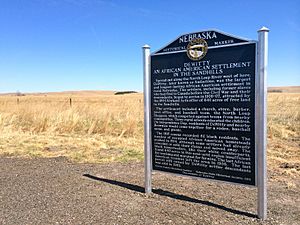DeWitty, Nebraska facts for kids
DeWitty, also known as Audacious, was a small town in Cherry County, Nebraska, USA. It was started in 1907 and closed down in 1936. The town was about 16 kilometers (10 miles) northwest of Brownlee. DeWitty became Nebraska's biggest and longest-lasting settlement for African American families who were looking for land to farm.
How DeWitty Started
In 1904, a new law called the Kinkaid Act changed the old Homestead Act. This new law allowed settlers in Nebraska's Sand Hills to claim larger pieces of land, up to 640 acres. This change encouraged many African-American families to move to the area.
By 1910, twenty-four families had claimed about 57 square kilometers (14,000 acres) of land in Cherry County. By 1920, 185 African Americans owned about 160 square kilometers (40,000 acres) around DeWitty. The town was named after a local African American business owner.
The First Settlers
Clem Deaver was the first African American to claim land in Cherry County under the Kinkaid Act. He was working in Seneca, a railroad town. Deaver went to Valentine to claim land. There, he found out that about 200 square kilometers (50,000 acres) of unclaimed land were available. This land was about 16 kilometers (10 miles) northwest of Brownlee. It also bordered the North Loup River for almost 24 kilometers (15 miles).
Deaver went back to Seneca and told others about the land. By 1907, new settlers had built many sod houses on the land. Sod houses were homes made from blocks of grass and soil. In just a few years, black Canadian farmers joined the settlement. They had previously settled near Overton in Dawson County. This brought the town's population to 66 people. By 1917, about 100 families lived in the settlement.
Life in DeWitty
During its history, the town of DeWitty was renamed Audacious. In 1910, Reverend O.J. Burchkardt started a church there. He was a missionary from the African Methodist Episcopal Church in Lincoln.
The town had a post office, a baseball team, and a barber. There was also a general store where people could buy supplies. For students, there were three different school districts. Every August, the town held a yearly picnic. People from nearby Brownlee were often invited to join the fun. The town also had a cemetery with almost twenty burial sites. Many young men from DeWitty served in World War I and came back home after the war.
Why DeWitty Ended
After World War I, DeWitty faced tough times. There were long periods of dry weather and crops failed. This made it hard for families to keep their farms. Many families had to borrow money and then lost their land to bankers. This happened to many small farmers across the Great Plains. People learned that the Plains were not always good for growing enough food to live on.
The last person living in DeWitty sold their land to white ranchers nearby in 1936. The way DeWitty's population changed was similar to other African-American farming towns in Nebraska. Even so, DeWitty was an important part of how farming communities grew in the American West during the time of the Kinkaid Act.
On April 11, 2016, the Nebraska State Historical Society put up a special sign. This sign is on U.S. Highway 83 and remembers the DeWitty settlement. About 200 people came to the dedication ceremony. This included 18 family members of the original settlers. They traveled from six different states to be there.
See also
 In Spanish: DeWitty (Nebraska) para niños
In Spanish: DeWitty (Nebraska) para niños


